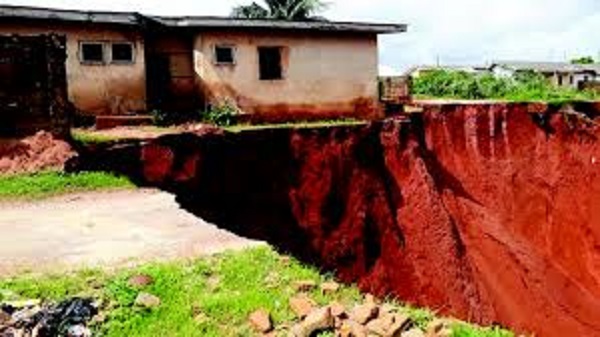{Originally published February 16, 2006}
Many have written on the subject of gully erosion and the calamities that follow the continued neglect and those that have befallen the folks who have unfortunately found themselves at the mouth of this impending danger. Others have also written demanding for a lasting solution from the political heads in the seat of leadership to get-up and do something meaningful to aid the alleviation of this impending calamity, while some other writers chose to chronicle the historical aspects of the gully erosion, instead. What is particular or rather peculiar is that while most of these concerned writers have written of their true concern, very few of them have explained why gully erosion poses a potent quagmire.
The fact of the matter however is that gully erosion has impacted the south eastern region of Nigeria adversely more than other part of the country, and like most other issues pertaining to the region, it has suffered its share of neglect in magnitudes that conjures up the days of the Nigerian civil war. The point to be made here is that the problem of gully erosion became principally symptomatic of the sorry state of mind Ndi Igbo developed following the end of the war. The state of mind points to nihilism – hatred of ones culture or ideals. So the contention is that the neglect of gully er osion by Ndi Igbo is just a sign of a bigger problem, it points to a people suffering from cultural defeat in hands of mental slavery. However the light seems to be flickering into a full glow, in that the spirit of Ndi Igbo appears to be showing signs of recovering from the tentacles of nihilism and xenophobia directed at self.
Ndi Igbo are developing a can-do attitude over the issue of erosion as the list of displaced families continues its growth each year. With their awareness that the federal government has shown little care towards the abatement of gully erosion in the said region, Ndi Igbo in the Diaspora have mounted an effort to create a renewed awareness for erosion gul lies scattered around the region. This was sparked by a recent agitation by the various Igbo organizations in America, in particular during the Association of Anambra State USA {ASA-USA} Convention of October 2005 held at Houston Texas {of which the Governor of Anambra was in attendance along with several house of assembly members}, it was during this convention that a duo presentation on ecological menace in Anambra State and Igbo land in general, caused tears to stream down the cheeks of many in attendance, including some of assemblymen. These teardrops are believed to have helped spark the rejuvenation of the cause for gully erosion to the current height that has not been seen in a long while.
While the awareness for gully erosion is gradually catching fire, the many political bodies in Nigeria appear to be gradually picking up steam over the possible political di vidend generated by this renewed awareness push. This is evident through the somewhat surprising response to the recent displacement of families in Aguata Orumba Local Government Area and in Nnewi by the various political representatives in Anambra, the same is evident in Imo State as the gubernatorial candidate for 2007, Chief Chukwuemeka Nwajiuba began orienting his campaign around the subject of erosion abatement and awareness; he states that it will be one of the primary functions of his administration.
The representatives of Abia State have been making calls to the federal government for more funds towards abating the spread and danger of gully erosion. A particular case is that of Isuikwato Local Government Area. In late January 2006, members of the Senate Committee on Special Duties and Conflict Resolution described the erosion and landslide sites in Isuikwato L ocal Government Area of Abia State as a ‘national disgrace. According to the chairman of Isuikwuato Local Government, Chief Charles Ojukwu, the “high powered visit” to the sites in 2001 by some of the federal political players, resulted to nothing to date. He continued to state that the landslide had cut off the “villages in Oguduasa clan, from the rest of the state, while Our Lady of Fatima Catholic Church, Oguduasa Secondary School and a filling station, near the Orumalo Oguduasa landslide site”, appear on the verge of submerging into the erosion gully. This particular erosion gully is estimated to be growing at the rate of 500 meters per year.
I should note that the federal government has been responsive to some extent to the States impacted by gully erosion but its response has been selective and negatively too political. The case of Anambra exemplifies this partiality. A nambra State is estimated to be the worst hit as per number of gully erosion sites and the potential to cause financial and human casualty, yet the federal government have selectively funded other abatement programs in other States with lesser erosion problems. According to documented evidence, up to 1000 major gullies are estimated to be in Anambra alone, which more than doubles the amount of gully erosion found in other States. However, Anambra State government did not give up due to the federal neglect.
The Anambra State Governor – Chris Ngige on July 2005 in collaboration with the Commissioner for Environment, Mineral Resources, Science and Technology, Dr. Okey Enemuo launched the “Green Cities – Plan for the Planet” project aimed at reinforcing the need for environmental education. At the occasion, the Governor rated Anambra State as the most devastated stat e in the South East geo-political zone and throughout the federation while highlighting that the State government’s lean purse is limited and cannot carry it alone. The federal government on the same July 2005 approved about N4 billion contracts for erosion control and water supply projects for Yobe, Enugu, Abia and Plateau states. Yobe State got the largest chunk of the fund with over N3.6 billion approved for water supply and another N12.6 million for the construction of gully erosion structure in Potiskum. By September of 2005, it was reported that of over 150 families have been displaced by erosion menace in Ekwulobia town in Anambra State. It raises the question as to why the disparity? T his disparity is explained away by some experts as rooted in the dispute between the Governor of Anambra State and the President of Nigeria, that the tussle for power between Governor Ngige and the self proclaim godfather Christian Uba was largely the cause for the undue neglect. Some others claim the fault lies with the lacking ability of the federal representatives to properly secure the necessary funds for their home State, that most of the representatives careless or know very little of the role they are supposed to play as per the erosion gully that has gradually eaten up the people in their district. The thing is that each assertion may be equally true. Citing the case of Agulu-Nanka/Oko-Ekwulobia axis exposes this in a whole-sell manner. It displays a disgrace for all the politically elected representatives, who supposedly represent the people of that “land” area.
Fol lowing the years after the end of the Second World War, the colonial masters found it necessary to arrest the problem and thus launched an intensive campaign of cashew plantation. Through this campaign, the erosion site in Agulu/Nanka site was effectively arrested – and the area was nicknamed “Agu Cashew”. The same was the case at Enugu “Ninth Mile” where the situation was arrested using “Melina trees”. Immediately following the advert of independence and self administration, these pertinent programs fell to the wayside. All hell broke loose. The cashew plantation that was formally catered and nurtured was now abandoned and ignored. Local communities who saw the pattern of behavior on the part of these political representatives began feasting on these trees, chopping them down for use as firewood. They began intensive collection of all the cashew {nuts} seeds that would normally be left on the floor to geminate more cashew trees thus halting further growth. Also, land development and faulty house construction increasingly begun an aggressive encroachment into the land where these cashew trees were previously standing. While this was going on, the politicians were busy auguring for their share of the State and Federal treasury. It was simply a caustic mix of faulty leadership and nihilistic follower-ship.
A new found hope with the renewed energy towards tackling the quagmire of erosion; harnessing it into a lasting exuberance able to execute and coordinate all the required aspects of the gully erosion abatement program would enable attainability. Because erosion gullies are hidden deep in the bushes of the rural communities, and not as public as roads and other public utilities; it is necessary to devise a better method of holding our elected representatives accountable for the continued awareness on the ongoing calamity of erosion. Perhaps as the collective prayers of Ndi Igbo in the Diaspora continue to percolate, the lasting answer to the gully erosion dilemma will find its way home.







